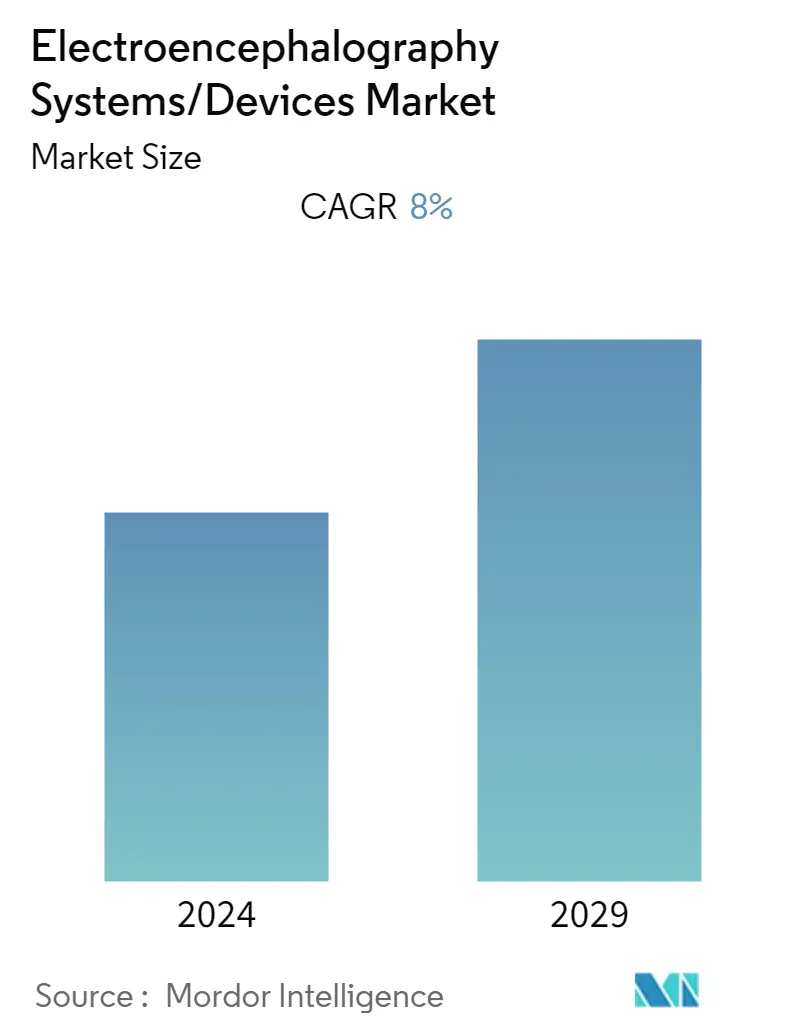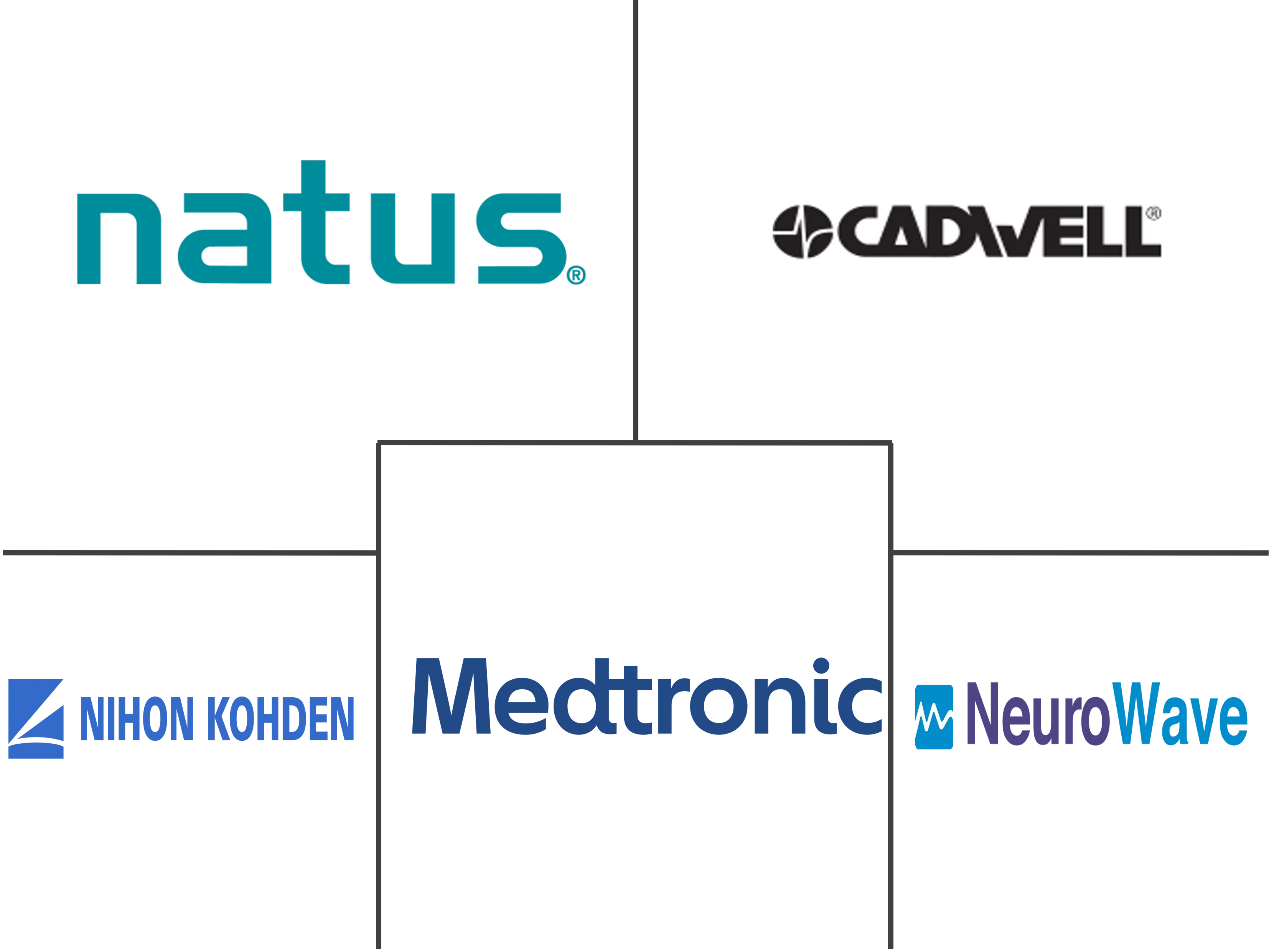Market Size of Electroencephalography Systems/Devices Industry

| Study Period | 2019 - 2029 |
| Base Year For Estimation | 2023 |
| Forecast Data Period | 2024 - 2029 |
| CAGR | 8.00 % |
| Fastest Growing Market | Asia Pacific |
| Largest Market | North America |
Major Players
*Disclaimer: Major Players sorted in no particular order |
Electroencephalography Systems Devices Market Analysis
The electroencephalography systems devices market is expected to register a CAGR of 8% over the forecast period.
The COVID-19 situation necessitated significant rearranging of health services, including neurological services. According to an article published in January 2021 titled "The impact of the COVID-19 pandemic on people with neurological disorders: an urgent need to improve the health care system's preparedness," data from Spain, particularly the Madrid area, show that 95% of hospitals have re-allocated neurologists to assist COVID-19 patients, and the number of beds in neurology wards has been reduced by 89%. The pandemic has exposed the lack of sufficient health care for patients with neurological illnesses, particularly in locations where hospital-community integration is already lacking. The shift in health resources for COVID-19 patients, along with social distancing measures, has jeopardized neuro-rehabilitation in the outpatient context and inpatient and home care settings. However, the market is currently gaining traction due to the significant increase in the use of electroencephalography devices globally due to the increasing number of heart diseases.
Electroencephalography is the only clinical diagnostic instrument to see brain activity and reflect cortical neuronal functioning in Alzheimer's patients. Moreover, high incidences of Alzheimer's epilepsy, multiple sclerosis, dementia, Parkinson's disease, and stroke are the key driving factors for adopting this electroencephalography, further triggering the market. For instance, as per the Parkinson's Foundation Statistics updates from March 2020, more than one million people were living with Parkinson's disease in the United States by 2020, and nearly 60,000 Americans are diagnosed with Parkinson's disease every year. Thus, because of the high incidence of neurological disorders globally, the electroencephalography system/devices market is expected to grow significantly over the forecast period.
Moreover, the data published in October 2021 by World Health Organization (WHO) reported that the pace of population aging is much faster than in the past, and 1 in 6 people worldwide will be 60 years or over by 2030. At this time, the share of the population aged 60 years and over will increase and will nearly double from 12% to 22% by 2050. As the aging population creates an increase in health-related issues, especially neurological diseases, the hospitalization of patients is also expected to rise. This hospitalization is likely to lead to the requirement for electroencephalogram (EEG) systems, and this is expected to drive the electroencephalography systems devices market.
Moreover, increasing product launches and product development promotes market growth. For instance, in August 2022, Myneurva launched Starrbase, a fully integrated system of its Advanced Neural Network Analysis (ANNA), with over fifty research-based brain training programs. Moreover, in February 2022, Masimo announced the United States Food and Drug Administration clearance of pediatric indication for SedLine brain function monitoring and the SedLine pediatric EEG sensor. Such factors potentially drive the demand for adopting electroencephalography systems/devices worldwide.
However, the limitation of the electroencephalography system is expected to hamper the growth of the electroencephalography systems/devices market.
Electroencephalography Systems Devices Industry Segmentation
As per the Scope, the Electroencephalography system is a device that uses a noninvasive technique to measure and records the electrical activity of the brain. The electroencephalography systems/devices market is segmented by Type (Portable Device, Standalone Device), End User (Hospitals Diagnostic, Centers, and Others), and Geography (North America, Europe, Asia-Pacific, Middle East and Africa, and South America). The report also covers the estimated market sizes and trends for 17 countries across major regions globally. The report offers the value (in USD million) for the above segments.
| By Type | |
| Portable Device | |
| Standalone Device |
| By End User | |
| Hospitals | |
| Diagnostic Centers | |
| Others |
| Geography | ||||||||
| ||||||||
| ||||||||
| ||||||||
| ||||||||
|
Electroencephalography Systems/Devices Market Size Summary
The electroencephalography systems/devices market is poised for significant growth, driven by the increasing prevalence of neurological disorders such as Alzheimer's, epilepsy, multiple sclerosis, dementia, Parkinson's disease, and stroke. These conditions necessitate the use of electroencephalography as a critical diagnostic tool, particularly in the context of an aging global population. The market is experiencing a resurgence following the disruptions caused by the COVID-19 pandemic, which had previously strained neurological services and highlighted the need for improved healthcare infrastructure. The pandemic's impact on healthcare resource allocation has underscored the importance of neuro-rehabilitation and the demand for advanced diagnostic systems. Additionally, the market is benefiting from technological advancements and product innovations, such as the launch of integrated systems and FDA-approved devices, which are enhancing the capabilities and applications of electroencephalography systems.
North America is expected to maintain a dominant position in the global electroencephalography systems/devices market, supported by a high incidence of neurological and sleep disorders, as well as a robust healthcare infrastructure. The region's market growth is further bolstered by increasing healthcare expenditure and the presence of major industry players. The market landscape is characterized by fragmentation and competition, with key companies like Natus Medical, Cadwell Industries, Medtronic, and Nihon Kohden Corporation leading the charge. The ongoing development and approval of innovative products, such as advanced EEG headsets and systems utilizing machine learning for signal analysis, are expected to drive market expansion. Despite the challenges posed by the limitations of existing systems, the standalone electroencephalography systems are anticipated to witness healthy growth due to their critical application in hospitals and healthcare settings.
Electroencephalography Systems/Devices Market Size - Table of Contents
-
1. MARKET DYNAMICS
-
1.1 Market Overview
-
1.2 Market Drivers
-
1.2.1 Rising R&D Expenditure
-
1.2.2 Increasing Prevalence of Neurological Disorders
-
-
1.3 Market Restraints
-
1.3.1 Limitation of Electroencephalography System
-
-
1.4 Porter's Five Force Analysis
-
1.4.1 Threat of New Entrants
-
1.4.2 Bargaining Power of Buyers/Consumers
-
1.4.3 Bargaining Power of Suppliers
-
1.4.4 Threat of Substitute Products
-
1.4.5 Intensity of Competitive Rivalry
-
-
-
2. MARKET SEGMENTATION (Market Size by Value - USD million)
-
2.1 By Type
-
2.1.1 Portable Device
-
2.1.2 Standalone Device
-
-
2.2 By End User
-
2.2.1 Hospitals
-
2.2.2 Diagnostic Centers
-
2.2.3 Others
-
-
2.3 Geography
-
2.3.1 North America
-
2.3.1.1 United States
-
2.3.1.2 Canada
-
2.3.1.3 Mexico
-
-
2.3.2 Europe
-
2.3.2.1 Germany
-
2.3.2.2 United Kingdom
-
2.3.2.3 France
-
2.3.2.4 Italy
-
2.3.2.5 Spain
-
2.3.2.6 Rest of Europe
-
-
2.3.3 Asia-Pacific
-
2.3.3.1 China
-
2.3.3.2 Japan
-
2.3.3.3 India
-
2.3.3.4 Australia
-
2.3.3.5 South Korea
-
2.3.3.6 Rest of Asia-Pacific
-
-
2.3.4 Middle-East and Africa
-
2.3.4.1 GCC
-
2.3.4.2 South Africa
-
2.3.4.3 Rest of Middle-East and Africa
-
-
2.3.5 South America
-
2.3.5.1 Brazil
-
2.3.5.2 Argentina
-
2.3.5.3 Rest of South America
-
-
-
Electroencephalography Systems/Devices Market Size FAQs
What is the current Electroencephalography Systems/Devices Market size?
The Electroencephalography Systems/Devices Market is projected to register a CAGR of 8% during the forecast period (2024-2029)
Who are the key players in Electroencephalography Systems/Devices Market?
Natus Medical, Inc., NeuroWave Systems, Inc, Cadwell Industries, Inc., Nihon Kohden Corporation and Medtronic are the major companies operating in the Electroencephalography Systems/Devices Market.

